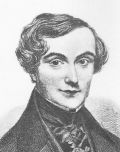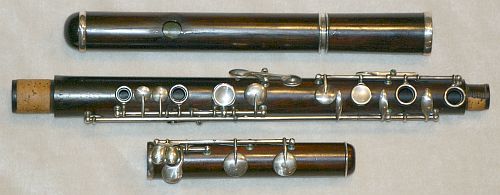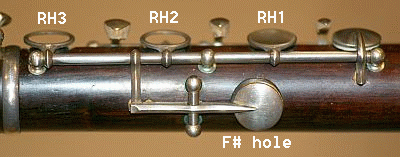

After mentioning that a critic suggested that the Clinton Equisonant flute was called by that name because it was "equally bad all over", R. S. Rockstro (1889) denied that this was true, saying "...it had not even that negative merit".

Well, I think it is a fine design (there are a few variants, but all fine designs). And quite clever! The instrument shown (from c.1858) has a conical bore and relatively large and relatively evenly spaced holes. So it sounds similar to an English conical Boehm flute or Siccama flute.

John Clinton (1810–1864) was an English flutist and flute manufacturer. He was an early advocate of the Boehm flute, but was impatient with its faults, which he enumerates in the introduction to his Code of Instructions (c.1860) for his Equisonant flute. See below. He even traveled to Munich to visit Boehm, but was not at all happy with Boehm's next effort at improvement, namely the 1847 model cylindrical flute. (Or perhaps he was unhappy because Boehm gave the right to manufacture it in England to Rudall & Rose, and not Clinton.) Much information about Clinton and his flutes may be found in The life and work of John Clinton by Adrian C. Duncan and Terry McGee.
All the keys of the 8-key flute are present on a Clinton Equisonant flute, except the long F key. There is a trill key for D/C and D/C# trills. In spite of the large holes, the forked F, fingered 1234-6, has been restored with the aid of two ring keys for RH2 and RH3. Either ring key causes an F# hole on the audience side of the flute to be closed. (This was also a feature on the Carte 1851 system, the Radcliff system, the Briccialdi system, and many Reform flutes.)

The net effect is a relatively even and loud instrument that can be played with the simple system fingering in the first two octaves, with minor exceptions. As mentioned, the forked F is available (and not the long F key); but this is for the better as it eases the playing of many passages. The perhaps unfortunate exception is that the normal 19C fingering for c'' and c''', namely -2-456K, does not work.
But the unique thing about the Clinton Equisonant flute is the following. On a simple system flute, you get Bb by fingering the A with 12---- and opening the Bb key with the thumb. You get a C by fingering B with 1----- and depressing the long C key with the right hand first finger. On Clinton's flute, both keys (for the thumb and RH1) perform both functions. You get C with LH1 and either the thumb key or the RH1 lever; you get Bb with LH1, LH2, and either the thumb key or the RH1 lever. Try to figure out how he did that! Here is the relevant portion of the flute:

We append the introduction to Clinton's A Code of Instructions for the Fingering of the Equisonant Flute of c.1860.
SEVENTEEN years have elapsed since my introduction of the Boehm Flute. After a careful examination of the system, I found it much superior to the ordinary Flute then in general use, I therefore adopted it myself, and recommended it to my Pupils, to render it available to all Flautists, I published two works; one entitled "An Essay on the Boehm Flute," the other "A Complete School, or Practical Instruction Book," in both of which I strenuously advocated the system; although my efforts met with much opposition, I felt confident that the improvements would eventually overcome the prejudice that existed, and the result has fully realized my expectations—the most vigorous opponents having since become warm advocates. A lengthened course of study, united to the experience acquired in constantly teaching Pupils of all degrees of talent and proficiency, proved more clearly to me, that, although the Boehm was much superior to the ordinary Flute, it admitted of still greater improvements. The faults I found, in common with all those who adopted it, and which are now universally acknowledged, are as follow: the constantly-recurring difficulties and ruggedness of executing passages arising from the fingering of F# and Bb; the cross and difficult fingerings in the third octave, and the absence of means to facilitate passages in that region of the Instrument; added to which, the tone in the third octave, (or upper notes) is much too sharp and thin in quality. My appeal to the manufacturers in this country to remedy the defects being unavailing, I undertook a journey to Munich to consult with Mr. Boehm. Our interview ended with the understanding that he would endeavour to carry out my views, and if successful, I was to have the sole right of his improvements in the Instrument for England. After a long correspondence on the subject, he brought over his Metal Flute with cylindrical bore and conical head, (erroneously termed "Parabola") like the Clarionet. A most careful and impartial trial fully convinced me, that, as a whole, he was as far as ever from removing the defects, or of perfecting the Instrument; and feeling that I could not adopt it with pleasure or satisfaction, nor conscientiously recommend it to my Pupils, I was (most reluctantly, I confess) compelled to decline it. I then commenced a series of experiments myself, which have ultimately enabled me to remove the faults above named. In humble confidence, I now offer to the consideration of Flautists an Instrument which combines the advantages of the Boehm Flute without its defects or difficulties. Doubtless with this, as with everything else newly constructed, many obstacles will arise to prevent its general adoption, and I may meet with as much opposition from my contemporaries in the improvements and manufacture of the Instrument, as I experienced when I first introduced the Boehm Flute. I hope, however, that as my views of the principle of that system were ultimately found to be correct, my exertions to perfect the same will (to say the least) meet with a fair and impartial trial. Having now realized all that can be desired on the Flute, namely—equality of tone and tune, and facility of fingering throughout—I submit this code of Instructions to illustrate the same, so that performers on the Boehm or ordinary Flute may adopt the Equisonant without trouble or difficulty. In writing this work, I have borne in mind that its principal use will be to supply examples in the absence of a master; to carry out that view with a probability of success, I have considered it necessary to repeat the same fingerings many times, not only to impress them upon the memory, but to save the student the trouble of turning back from page to page. I mention this at the outset, lest, from a superficial glance through the work, it may be imagined there are a multiplicity of different fingerings to be learnt.
The Equisonant Flute has one fingering for each note, which I have termed the natural fingering; that being simple and direct throughout, it provides for nearly every passage in the ordinary run of Flute music; but as this, like every other musical instrument, requires an occasional deviation for certain rapid and continuous successions of notes, which deviations or modifications I have termed exceptional fingerings, they ought to be learnt by those who wish to become finished performers; they are, however, so closely allied to the natural fingering, and the reasons for their adoption so palpable, no difficulty or taxing of the memory will be experienced. It may perliaps be urged by some, that I have entered too minutely into their detail, but long experience as a teacher has convinced me of the necessity of repeating the example many times to some learners before it becomes permanently fixed in their mind. I have purposely omitted the Elementary Instructions in Music, having already written three works devoted to that branch of Flute playing, either of which may be made available for the Equisonant by substituting the fingering in the last page of this work.
Having perfected this favorite Instrument as far as its capabilities will possibly admit, I feel persuaded my improvements will remove the difficulties which have hitherto beset the amateur's path. In conclusion, I earnestly recommend a careful study of the following pages.
J. CLINTON.
35, Percy Street, Tottenham Court Road.
